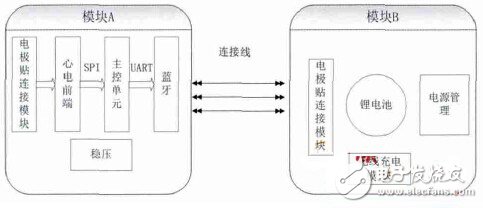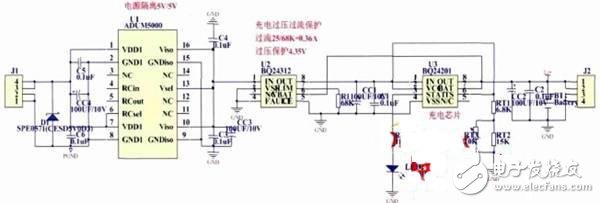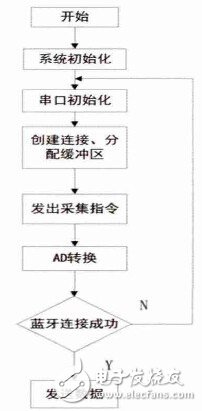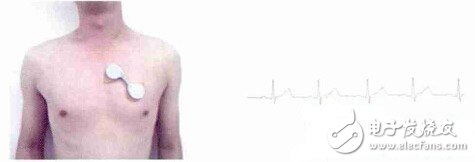ECG signal is one of the earliest human bioelectrical signals researched and applied in medicine and clinic. Compared with other bioelectrical signals, ECG signal is easier to detect and has more intuitive regularity. Due to the suddenness and long-term nature of heart disease, heart patients often need long-term treatment and monitoring. Therefore, it is extremely important for patients to record their ECG for a long time. Long-term ECG recording can record transient abnormal ECG events that are not likely to occur when the ECG is detected. This provides an important basis for disease analysis. ECG monitor can only monitor ECG signals when it was first applied in the 1960s. It is called single-parameter monitor. With the advent of large-scale integrated circuits and microprocessors, current ECG monitors have been able to monitor dozens of parameters. In view of the difficult recognition of ECG signals and the professionalism of ECG monitoring related operations, the implementation of ECG monitoring is often limited to hospitals and health institutions, and the daily ECG monitoring of patients is not easy to implement. The wearable medical instrument has basic function modules such as physiological signal detection and processing, signal feature extraction and data transmission, and can realize non-invasive continuous monitoring, diagnosis and treatment of human body. In traditional electrocardiographs, the hardware devices are mainly connected by communication cables. The operating platform is also based on wired devices. Although it has certain applicability in certain occasions such as hospitals and communities, it is not compatible with existing ones. The integration of personal communication terminals (such as mobile phones, PDAs, laptops, etc.). In view of this situation, this study designs and implements a more convenient and comfortable wearable wireless ECG recorder under the premise of ensuring the quality of signal acquisition. It adopts the low-power ECG acquisition chip ADS1191 and low-power single-chip microcomputer. MSP430F2112 constitutes a signal acquisition circuit, and the collected ECG signals can be transmitted to the communication terminal for display and analysis through Bluetooth; and the entire device is completely sealed by using wireless transmission and wireless charging technology to achieve the waterproof function and meet the medical safety standards. The wearable wireless ECG recorder should have features such as low power consumption, small size, and high processing speed. The size of ECG electrodes used in this study was approximately 30-75 mm. Taking into account the supporting ability of ECG electrodes, the expected height of the device in this study is about 0.5 cm and the weight is <30 g. The simulation results show that ECG electrodes can well support the volume and weight of the device, and will not fall off during exercise. Electrocardiograph is mainly composed of electrode paste connection module, ECG front end, main control unit, Bluetooth module, wireless charging module, lithium battery, voltage regulator and power management module. Block diagram, see Figure 1. The design of ECG signals on the body surface has the characteristics of weak amplitude and susceptibility to interference. The ECG signal collected by this module undergoes preamplification through a differential amplifier circuit with high input impedance to suppress zero drift and reduce the interference of the common mode signal. After the signal is further amplified (about 1000 times), the interference signal is filtered out again. Level up; then sent to the core processing controller for processing. This module is implemented by TI's ADS1191 low-power ECG acquisition chip. After the ECG signal is filtered, amplified, and A/D converted, it is sent to the low-power microcontroller MSP430F2112 for further analysis and processing through the SPI transmission mode. Wireless transmission is implemented using the HM-6 Bluetooth module (produced by Huamao Technology Co., Ltd.) for pocket devices. Wireless charging technology originates from wireless power transmission technology. The mainstream wireless charging technologies are mainly implemented in three ways (electromagnetic induction, radio wave and resonance). The wireless charging module uses Qi wireless charging technology and BQ24201 charger. Qi is the world's first standardization organization to promote wireless charging technology - Wireless Charging Alliance (WPC) launched the "wireless charging" standard, with two features of convenience and versatility. Qi's wireless charging technology uses magnetic resonance to transfer charges in the air between the charger and the device. The coils and capacitors form resonances between the charger and the device to achieve efficient transmission of electrical energy. The basic principle is to form the two coils. Resonance thus enables wireless transmission of electrical energy. BQ24201 is a charger for Li-Ion or Li-Polymer that integrates internal high-precision voltage regulation, power MOSFET, temperature monitoring, state of charge, and charge termination circuitry on a single chip; fewer external components save space and cost . The power management module uses the BQ24312 as a front-end protection scheme for Li-Ion chargers and provides 4.25 V overvoltage protection. The ADuM5000 is used for power isolation. The ADuM5000 is an isolated DC/DC converter based on Analog Devices technology. The circuit provides 5 V power isolation. According to product requirements, the ECG recorder needs to perform the collection and transmission of an uninterrupted ECG signal for > 4 h. After estimating the overall circuit, this study intends to use a 90 mAH rechargeable lithium battery. Power supply part of the charging circuit, see Figure 2. The lithium battery provides a stable 3.3 V digital voltage and analog voltage for the ADS1191, MSP430F2112, and Bluetooth modules via the MIC5205LB regulator chip. The ECG recorder software development environment uses the IAR Embedded Workbench, a cross-compiler designed by IAR for MSP430 microcontrollers, and is written in C language. System software flow chart, see Figure 3. In order to meet the low-power design requirements, this study uses the following methods to control power consumption in software design: 1 According to the function, the software is divided into several relatively independent modules, which are triggered by interrupts; 2 The software is used to control the chips that are not working at the moment to enter hibernation or idle state; 3 The program with short machine cycles is used to optimize each module program and reduce the actual system. Runtime, which reduces system power consumption. The physical map of the ECG recorder designed and implemented is shown in Figure 4. As can be seen from FIG. 4 , the recorder is mainly divided into two parts, each having a diameter of about 30 mm, a thickness of about 5 mm, an overall length of about 10 cm, and a weight of 25 g; the connecting line between each other includes a ground wire and a power supply wire; the electrode is attached to the back Embedded electrode buckle, directly buckled on the electrode when used. The position of the electrode patch is about 3 cm below the midline of the left clavicle, as shown in Figure 5. The power consumption of the ADS1191 electrocardiograph ECG acquisition front-end processor and the MSP430F2112 processor is 0.98 mA, and the power consumption of the Bluetooth real-time transmission data is 16 mA. Figure 6 shows the ECG waveform when a male subject was tested. It can be seen that the ECG waveform after preprocessing such as denoising and smoothing is stable, the baseline drift is not obvious, and the characteristics of P, QRS and T waves are obvious. Can be used for arrhythmia analysis. (1) Input impedance. Generate a “100 mV 10 Hz†sine wave from the signal generator and connect a 620 kΩ resistor to the input of the ECG recorder. The measured signal generator has a sine signal amplitude of U=98.8 mV and the voltage at the input of the recorder. At 95.84 mV, the input impedance of the ECG recorder R=20.07 MΩ was calculated. According to the National ECG standardization document, the input impedance of the ECG machine must be ≥ 2.5 MΩ. Therefore, the input impedance of the ECG recorder complies with industry standards. (2) Frequency response. In the test circuit, the signal generator's output signal frequency is continuously changed from 0.1 Hz to 150 Hz (commonly referred to as "sweeping") and maintained at a constant amplitude of 100 mV at the output via an oscilloscope or other recorder. The amplifier records the corresponding output level of this continuous change, and the frequency response curve of the device can be obtained. In the frequency range of 0.1 to 150 Hz, the fluctuation amplitude of the signal amplification of the electrocardiograph is 2.37 dB, which is less than the nationally specified 3 dB and meets the requirements. (3) Common mode rejection ratio. The common mode rejection ratio refers to the ratio of the amplification factor at the differential mode input and the amplification factor at the common mode input, which reflects the anti-interference ability of the electrocardiograph. First measure the amplification of the common-mode input, introduce the "1.5 V / 50 Hz" signal from the signal source, input it to the short-circuited input, connect the signal source ground to the right-hand drive, and record the output signal amplitude; The input signal amplification was compared and the calculated common-mode rejection ratio was 106.4 dB, which was in line with the national ECG standard. The portable ECG recorder designed and implemented in this study has low power consumption and small size and has the following features: 1 It is easy to operate, simple to measure, inexpensive to use, easy to use; 2 non-invasive, safe, accurate, and repeatable; 3 Real-time waveform display; 4 with wireless charging. The ECG recorder can be widely used in the long-term real-time monitoring of ECG signals.
Laptop power adapter charger for HP:
Our service:
Stable output and high charging efficiency.
Elegant outlook design as original one, touch smoothly and comfortable.
Original charger is good, but as a replacement, our product has more reasonable price when your original charger is broken.
And, the market of the replacement adapters becomes bigger and bigger. People would rather buy a copy one then the original because of the price.
But at the same time, people worry about that they will buy something defective. So the problem comes, how to buy a good quality one with a good price?
As a professional power adapter manufacturer, we have excellent R&D team, skilled staffs and responsible after-sale service. All your benefits can be under protected after you buy products for our company.
Our certificates :ISO9001:2008 & ISO14001:2004 , CCC , CE , FCC , ROHS.
All our products has 1 year warranty. In other words, if you get the dad products which are not damaged physically from us in one year, we will replace you the new one or the whole bulk order.
Laptop Adapter For Hp,Hp Laptop Adapter,Charger For Hp,Power Supply For Hp Shenzhen Waweis Technology Co., Ltd. , https://www.waweispowerasdapter.com
Figure 1 Blockage of a wearable wireless ECG recorder 
Figure 2 power supply part of the charging circuit 
Figure 3 ECG recorder software flow chart 
Figure 4 Electrocardiograph physical map, where (a) is a front view, (b) is a rear view. 
Figure 5 Electrocardiograph usage diagram left Figure 6 Receiver ECG waveform right
Laptop Brand
Power Adapter
EliteBook 8440p 6530b
18.5v 3.5a, 7450
Compaq 6500b 6530b 6535b 6700b 6730b 6735b 6736b
19v 4.74a, 7450
Pavilion DV4 DV5 DV6-1000 CQ60 CQ61
18.5v 3.5a, 7450
COMPAQ Mini
19v 1.58a, 4017
2710p 2730p 2740p 2740w 2760p
18.5v 3.5a, 7450
Pavilion DV4 DV5 DV5T DV6 G50 G60 G70 HDX16
18.5v 3.5a, 7450
dm4-1000 Dm4t-1000 Dm4t-1100 DV3-4000 CQ42
18.5v 3.5a, 7450
Compaq Presario CQ42 CQ57 CQ72 CQ56 CQ32 CQ32-101TX I84C
18.5v 3.5a, 7450
G62 Compaq Presario CQ42 CQ72 CQ62 CQ56 CQ32 593555-001 DM4
18.5v 3.5a, 7450
DV4 DV5 DV6-1000 DV6-1200 DV6-1300
18.5v 3.5a, 7450
DV4 SPARE
18.5v 3.5a, 7450
dv4-1120us dv4-1200 dv6-2150us dv6-2155dx dv6-1245dx
18.5v 3.5a, 7450
Pavilion DV1000 DV1100 D1200 DV1300
18.5v 3.5a, 4817
DV1000 M2000
18.5v 3.5a, 4817
EliteBook 2730p 2740 2760p Compaq 2710p nc6320
18.5v 3.5a, 7450
Compaq 320 321 325 326 420 620 621 421
19v 4.74a, 4817
Pavilion dv4000 dv4100 dv4300 dv4400
19v 4.74a, 4817
Compaq DV1000 G3000 G5000
18.5v 3.5a, 4817
dv4-5000 dv6-7000 dv7-7099
19v 4.74a, 4817
dv6-7200 dv7-7200 DV4-5000 DV7-7000
19v 4.74a, 4817
DV4 DV6 CQ60 CQ70 G50 G70
18.5v 3.5a, 7450
ProBook 4340s 4341s
19v 4.74a, 7450
Pavilion DV3
19v 4.74a, 7450
ProBook 4320s 4321s 4325s 4420s 4425s 4525s
18.5v 3.5a, 7450
dv2000 dv6400 dv6700 dv6800 dv6900 A900 V6400
18.5v 3.5a, 4817
Compaq 420 421 425 4320t 620 625 320 321 325 326 621
18.5v 3.5a, 7450
ProBook 6440b 6445b 6450b 6540b 6545b 6550b 6555b
19v 4.74a, 7450
Pavillion DV7
19.5v 4.62a, 7450
G42 G72 G32 DV7-4000 DV6-6000 DV5-2000
19.5v 4.62a, 7450
Presario CQ32 CQ42 CQ43 CQ56 CQ62 CQ72
19v 4.74a, 7450
Pavilion DV6 DV6-3000 DM4-1000 Envy 15 17 G4 G6 G7-1000
19.5v 4.62a, 7450
avilion dm3 dm3-dm3t-1000 CTO dm3-1000 dv4-3100
19.5v 3.33a, 4817
DV4 DV5 G50 G60 G61 G70 G71 HDX16
19v 4.74a, 7450
CQ40 CQ50 CQ60 CQ61 CQ70 CQ71 DV4
19v 4.74a, 7450
CQ60 CQ61 CQ40 CQ41 CQ45 CQ60 G60 G70
19v 4.74a, 7450
Pavilion dm3 CTO dm3-1000 dv4-3100
19v 4.74a, 7450
Compaq 6520 6520P 6520S 515 516
19v 4.74a, 7450
2000-425NR
19v 4.74a, 7450